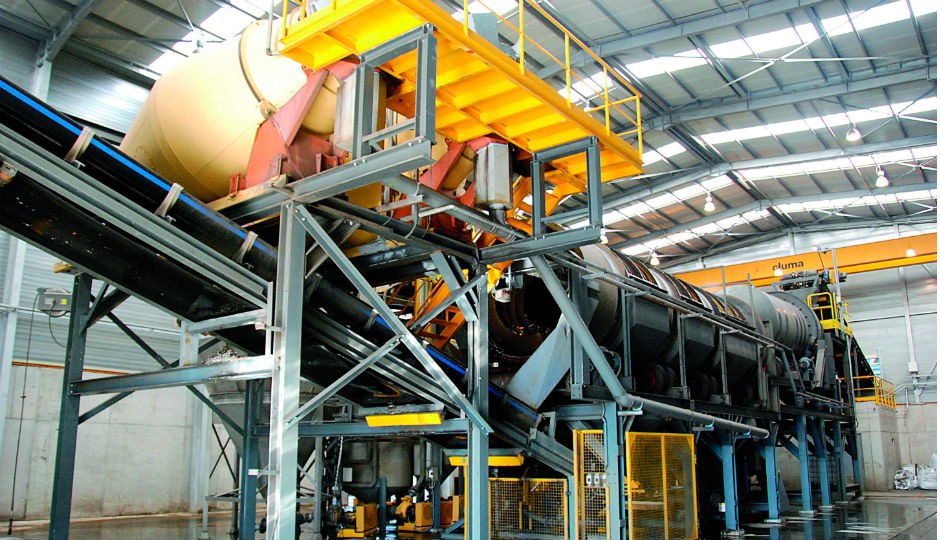
Designed, engineered and manufactured by Belgium-based Galloo Recycling Solutions (GRS), the GRS Dense Medium Separator uses dense medium drums specifically designed for highly preciseseparation of plastics from non-ferrous metals. This technology is also ideal for processing shredder residue (SR), and Zorba (mixed materials obtained from SR).
According to Galloo, the high-precision capability of the GRS dense medium drum is achieved by using a very stable medium. A typical dense medium bath is relatively deep, which makes it difficult for suspended particles to remain in suspension. An unstable medium means that water can be found at the top of the bath, while a dense sludge remains at the bottom. For this reason, GRS says they developed a shallow bath that provides just enough agitation to keep the suspension medium stable.
Using a GRS dense medium separator, recyclers can handle a wide range of materials ranging from WEEE to plastics and minerals, as well as Zorba, ASR and other shredder residue. Depending on the size of the drum, particle sizes ranging from 4 to 200 mm can be processed, with units providing recovery of all metals.
According to Galloo, dense medium separation and heavy media plants can be used in multiple ways in shredding and scrap recovery operations.
At this year’s ISRI convention, in April, Galloo says they encountered many companies who were looking at the possibility of incorporating density separation technology into their operations.
Processing Zorba
“We have seen, in the U.S., that there is a lot of interest in separating Zorba material (mixed metals) with heavy media separation,” explains Luc Waignein, director R&D, Galloo N.V.
“Zorba is a mix of materials obtained by separating shredder residue (SR) with eddy current separators.” Waignein adds that much of the Zorba produced currently is being sent to China for further separation, and that a large percentage of the metals in the Zorba mix (up to 85 percent) is aluminum.
“What is happening now is that the price for Zorba is dropping which causes a large difference between the price of Zorba and clean aluminum. With our heavy media system we are able to separate Zorba into aluminum, heavy metals and a mix of magnesium and waste.
“We do this by separating the material in two density steps,” continues Waignein. “Our system uses a first separation drum which has a fluid (medium) inside it with a specific gravity (SG) of 2.2. On this density, the magnesium and waste will float while the other metals will sink. The metals which sink are sent to a second separation drum with a medium at 3.2SG. On this density, aluminum will float and the heavy metals will sink. The three materials coming out of the material are then rinsed after the separation process.”
According to Brian Noppe, sales engineer, Galloo Recycling Solutions, “Through this separation method it is possible to achieve an added value of $0.05 per pound, which is around $110/metric tonne. Currently, the added value would even be around $300/mt due to tensions on the market. If the cost for processing the material is around $70/mt, this would result in a net profit between $40- and $230/mt.”
“By using this technology we allow recyclers to produce products which can be sold domestically,” Noppe says. He adds that Zorba material produced in North America does not have to be shipped to China, where there is a chance that the current restrictions there (green fence) could be a hindrance to delivery. “By keeping materials for processing in North America, it increases revenues for domestic recyclers, while helping the environment by reducing transportation.”
Processing shredder residue
“In this case we start with the shredder residue as it comes out of the shredder,” explains Waignein. “The biggest advantage of doing a dense and heavy media separation on shredder residue is that there is no loss of metals. If material is separated with an eddy current system then metals will be lost, because an eddy current system can never detect all the metals. Because our dense and heavy media is based on density rather than on eddy currents, all metals will always be detected.”
Noppe adds that with their system, shredder residue is first pre-treated through sieving and wind-sifting. Afterwards it is sent to a washing drum to clean dirt and sand from the material, so that it is kept out of the dense medium. In the dense medium, material is separated at a density of 1.4SG. At this density plastics will float and metals will sink. The metals mix will continue to the heavy media plant and will go through the process described above, same as with Zorba.



